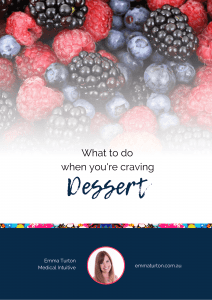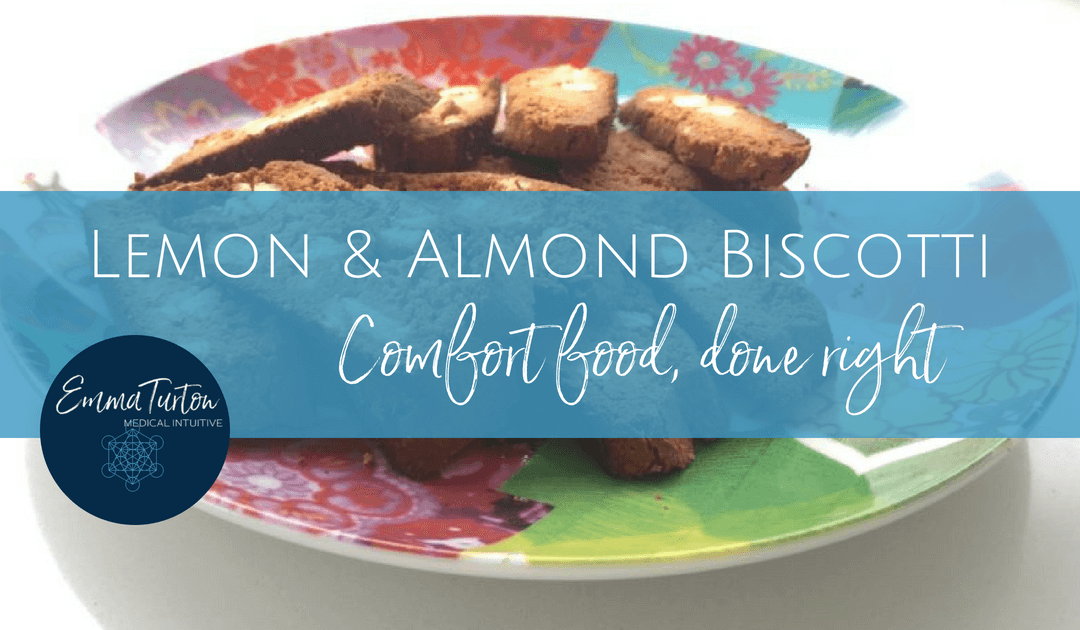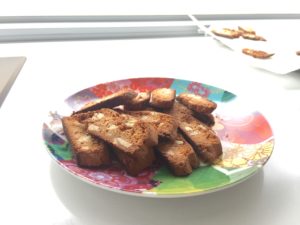The weather is getting colder and wetter here in Perth, now that we are heading towards winter. Even though the sun is shining as I write this, I’m wrapped up in a cuddly cardigan and sipping my heart-warming lemon and ginger tea, defrosting my chilly fingers on my cup as I sit at my computer. At this time of year, deep in my body I’m craving that warm nurturing feeling. You know the one… you feel wrapped up and supported in a giant hug of gentle cosy warmth…
Somehow, somewhere along the line, that nurturing feeling became inextricably linked to food.
Comfort food, we call it.
For some it’s hearty stews, slow cooked roasts, or gently simmered soups served with a crusty loaf of bread. For others it’s cheesecake or chocolate, or perhaps even a cheeky handful of marshmallows or snakes from the pantry, eaten before the kids see. For others, still, it’s a biscuit or cookie with a nice warm cup of tea or fresh coffee.
But does food really give us comfort?
Does it meet the deeper need that we have, beyond simple nutritional requirements or energy requirements? Can food really satisfy our deeper need for comfort and support?
Sometimes food can really, truly, support our needs on a deeper level. For example, when we are sick or run down, hearty stews and soups that have been lovingly prepared using wholesome, nourishing ingredients are exactly what we need, both on a nutritional level and on a deeper, soul nourishing level. Our immune systems thrive on this type of food when we are sick, and we can support our recovery from illness, injury, surgery and childbirth by eating a diet rich in slow cooked bone stocks and broth, along with the balance of quality protein, healthy fats and vitamin- and mineral-rich vegetables found in homemade stews, casseroles and soups.
I’m not talking about the stuff that comes out of a can or sachet here! Although that may FEEL like it’s meeting your comfort need, it wont be meeting your nutritional needs and can even provide more stress on your immune system, thanks to the heavy processing of the ingredients, the high sodium content, the hidden nasty ingredients and additives, and the chemicals that can leach into the food from the can lining. If you are unwell and needing this type of food but can’t make it yourself, then ask a trusted friend or family member to make some for you to aid in your recovery. But it can be as simple as throwing a bunch of different ingredients into a slow cooker or oven proof casserole dish with a lid, putting it on gentle heat, and coming back a few hours later to enjoy a tasty and nourishing meal.
But what about the other foods?
The cakes, lollies, biscuits, cookies, breads and pastries can so easily become a comfort crutch: Something to prop ourselves up on when we feel like we need a little something.
To find out if they are REALLY meeting your needs, follow these three simple steps:
- Become aware: Pause before you order or reach for the food or the fork. Ask yourself if there is something else that you really want instead? Are you eating to comfort or reward yourself or because you are really hungry? Does eating this food support your goals or is it going against what you actually desire for your health and life? And if you are eating to comfort yourself, will this food provide real, tangible comfort, like an actual hug or a phone call to a good friend or reading a good book tucked up on the couch under a blankie? If you are eating to reward yourself or because you “deserve it”, does your body really deserve a low nutrition sugar-hit? Is it really a reward for your body? Is there something else you want more?
- Make a conscious decision: To eat or not to eat, that is the question. Actually decide whether you will eat the food. Don’t just eat it out of habit, or because you’re busy watching tv while you eat and didn’t really notice whether you were hungry or not anyway. Think about it and weigh it up. Is this really meeting your needs and helping to support your goals?
- And if you go ahead and eat the food, ask yourself after: Did it help? Don’t guilt-trip yourself, but be curious. Ask yourself how do you feel now? Did eating this food support your goals and make you feel good about yourself? If yes, then by all means indulge from time to time. If not, then it might be time to implement a Nurturing Strategy!
What is a Nurturing Strategy, I hear you ask?
It’s simple. Make a list of all the things you can do to feel comforted, supported and nurtured, or that you enjoy doing that lift your spirits. They don’t have to be grand activities, just easy things that you know bring you joy. Some examples are ringing a good friend for a chat, going for a walk in nature, sitting in a sunbeam, reading your favourite book, listening to your favourite music, walking your dog, playing with or cuddling your pets, taking a hot shower or a long bath, drawing a picture, writing in your journal, having a good hug, laughing at a funny tv show, sitting in a garden or park instead of sitting in your house or office, writing a letter, email or text to connect with someone you haven’t seen for a while… Whatever lights YOU up.
And start scheduling these in throughout your day. The idea isn’t so much to replace the comfort crutch food with an activity, more that you will feel so happy, satisfied and comforted by your new routine that you won’t even think to reach for the cheesecake.
And if there is an association issue, by which I mean you associate the comfort crutch food with another activity, like eating a biscuit with a cup of tea or coffee, then replace the habitual comfort crutch food with either a Nurturing Strategy at the same time or a high nutrition alternative. So when you stop for a cuppa, take it out into the garden and sit in a sunbeam. Or call a friend and have a laugh and a chat while you drink it instead of looking to food to nourish your soul.
Or if all else fails, have a high nutrition recipe on hand, like this one, so you get more than just empty calories from your biscuit habit!
Lemon & Almond Biscotti
Vegetarian, Vegan, Gluten Free, Dairy Free, Egg Free, Refined Sugar Free, Paleo
1/4 cup raw almonds
1 & 1/4 cups almond meal, tightly packed
3 tsp arrowroot powder (coconut flour will work, too)
1/4 tsp salt (preferably Himalayan or Murray river pink salt, or celtic sea salt)
1/4 tsp bicarbonate of soda
1/4 cup pure maple syrup
zest of 2 lemons, grated
Preheat oven to 180C degrees. Line a baking tray with baking paper.
Place a dry frying pan on the stove on medium heat and toss in the raw almonds. Shake pan occasionally until toasted lightly. Remove nuts from pan and chop roughly. Set aside.
Meanwhile, in a food processor or blender, combine all remaining ingredients (without the toasted almonds) and blend until well combined and the mixture comes together into a dough.
Remove dough from processor and place in a small bowl. Stir through chopped almonds.
With clean damp hands, shape the dough into a long thin sausage shape (or two, if your baking tray isn’t long enough), place it on the paper lined baking tray and smooth the sausage shape over with your hands.
Bake at 180C degrees for 15 minutes. Remove from oven and cool for at least 1 hour.
Place the biscotti sausage on a bread board, and using a sharp bread knife, carefully slice it into 0.5cm wide slices on a diagonal. Don’t stress if it crumbles a bit! At this point the inside of each biscuit is still soft and you should be able to mould any bits that fall off back onto each biscuit so they’re the right shape. Lay them all out on their sides on the baking paper lined baking tray.
Bake at 150C degrees for approximately 10-12 minutes, or until golden all over.
Remove from oven and allow to cool.
Enjoy with a cuppa!
These keep well in an air tight container for a couple of weeks, but mine never last that long.
All measurements are in Australian standard cups (250mL), tablespoons (20mL) and teaspoons (5mL).
Copyright Emma Turton 2016.
Emma Turton
Leading International Medical Intuitive
Founder & Director of Medical Intuition School
Certified Medical Intuition Practitioner, PMIPM, Certified Intuitive Guide, BSc(Physiotherapy), APAM, CTNC, Functional Nutritionist, Certified Meditation Teacher
Professional Biography
Download my eBook

What to do when you're craving dessert.
Filled with stacks of soulful strategies and some sweet, healthy recipes to help you stay high-vibing and on track - download your free copy now.
And as an added bonus you will become part of my inner circle so you can be the first to hear about special offers and upcoming training.



